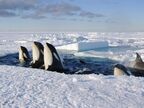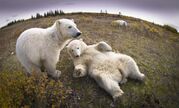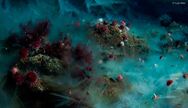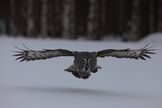Each animal can be given its proper name and position in this hierarchy. In order to more accurately express the taxonomic status of species, in practical work, the general classification of sub-categories is generally adopted: Kingdom Kingdom, Phylum, Subphylum, Superclass, Class, Subclass, Subclass, Superoder, Order, Suborder, Superfamily, Family. Subfamily Subfamily Genus Subgenus Subgenus Species Subspecies Subspecies
1, polar bear polar bear Chordates
- Vertebrate subphylum - Mammalia - Eutheria - Carnivora - Split foot The
world's largest terrestrial carnivore, Male polar bears weigh 300-800kg, while females weigh only half that of males. Although it is huge in size and not docile in temperament, and has a habit of actively attacking people, it looks completely warm and white (●—●), and it is very naive when walking. They spend most of their lives resting, and live amphibious lives in the ice floes from March to May every year. There will be a 3-day estrus period, and the male will follow the female's breath, step by step along the The footprints go to find the female. After a short mating, the mother conceives, gives birth, and nurses alone. After the age of 3, she survives alone. The father has no chance to see his children, so every polar bear is a solitary existence. .
2. Short-tailed shearwaters Chordates
- Avians - Least Concerned Species
Beginning in early May, small groups gradually wandered toward the North Pacific. Eighteen million migratory birds from Australia, 16,000 kilometers away, came to the North Pacific Ocean and gathered into the largest seabird flock in the world. They breed by nesting in groups, with original nests and fixed mates, foraging during the day, nesting at night, and laying eggs in holes. They often follow whales and whaling boats to peck, and interestingly, they have difficulty taking off on land, and usually need to climb to a high place and go down to complete the take-off.
3. Humpback whales
chordate-vertebrate sub-phylum-mammal-animal sub-class
tropical warm sea cetaceans, short and wide, up to 13-15 meters long, fat and bloated, but with beautiful lines The arched back and the huge tail fin are five meters long, which is very beautiful. They migrate regularly from north to south every year, feeding in cold waters in summer and breeding in warm waters in winter.
4. Reindeer caribou: Chordate
- Vertebrate sub-phylum - Mammalia - Eutheria. Vulnerable species
are distributed in North America. The female deer is 150kg, and the male is slightly smaller. It has dendritic horns and is replaced once a year. They have to make a large migration of hundreds of kilometers every year. As soon as spring arrives, they leave the forests and grasslands in the sub-Arctic region where they overwinter, and set off northward along the same route for hundreds of years. , eat while walking, travel day and night, take off thick winter clothes along the way, and give birth to new thin summer clothes, and the fluff that takes off falls on the ground, which just becomes a road sign. The migration is also the time for the doe to give birth. The cubs can follow the doe for two or three days after giving birth. After a week, they can run as fast as their parents.
5. Wolf Wolves Northern Canada
6. Bison buffalo The largest terrestrial animal in North America
7. 7.1 Penguins
exist only in the southern hemisphere
7.2 Gentoo Penguins
8, 8.1 Killer whale
Chordate - Vertebrate subphylum - Mammalia - Eutheria - Tooth whale - Dolphin family,
the largest species in the Least Concerned Dolphin family. Its most prominent feature is the large and towering dorsal fin. The dorsal fin of female whales and juvenile killer whales is sickle-shaped, while adult males are mostly upright like spines. The body color pattern of killer whales is black and white, which is very beautiful and has a very long lifespan. Female killer whales can even live for 80-100 years. Killer whales are distributed all over the world, and some of them have settled in Antarctica for a long time. The group belongs to a "matrilineal society". There is no stable father-son relationship, and the mother-son relationship can last a lifetime. In the predation scene shown in the film, the group swims silently, forming huge waves with rapid swimming and flapping to break the ice floes and hunt seals, which is very terrifying.
8.2 Minke whales Chordates
- Vertebrate subphylum - Mammalia - Eutheria - Minke whales - Baleen whales, less endangered species
Minke whales usually swim alone or in groups of 2 to 3, sometimes in the bait field form large groups. In the body pattern, there is a white horizontal band about 20-35 cm wide in the central part of the fins, and the subspecies of the slug whale in the Antarctic waters does not have this white horizontal band. The body is short and stubby, the head is small, and I personally think it looks like a spindle. Their racial trend is stable. They give birth once a year, with one litter per litter, and occasionally twins. They belong to the second-class national protected animals.
9. Antarctic fur sea lion Southern sea lion
Chordates - Mammalia - Carnivora -
Pinnipedia Sea lion family Antarctic fur sea lions, also known as Antarctic fur seals, are mainly distributed in Antarctic waters, of which about 95% live in South Georgia Island and Nansan Wich Islands. Its scientific name comes from the SMS Gazelle, the first German ship to capture it. Captain Cook, after exploring South Georgia in 1775, mentioned the large number of fur seals on the island. Antarctic fur seals only eat krill, but their bad breath is 10,000 times as bad as the smell of the stiniest dog, and a bite from their bacteria-laden mouths can lead to bacterial infection. Disgusting.
10.
There are 13 genera and 18 species under the seal Chordate - Vertebrate subphylum - Mammalia - Carnivora - Pinnipedia - Seal family
Seal is a general term for the pinnipeds, which are mammals with a spindle-shaped body and specialized flipper-like limbs. Seals have a round head and a short neck and no external auricle. They spend most of their time in the ocean and spread all over the sea, with the largest number along the Antarctic coast.
10.1 Weddell Seals Weddell Seals The Weddell Seals
are highlighted in the film, which was named by James Weddell, a British Antarctic nautical explorer. Young Weddell seals have dark, bright eyes and are very cute. This seal is mainly distributed in the waters around Antarctica and the coast of Antarctica. It can dive to 600 meters underwater and stay underwater for more than 1 hour. Due to its docile temperament and severe tooth wear due to breathing, it is very popular with hunters, but it cannot hunt by itself, and its lifespan is very short.
View more about Frozen Planet reviews











